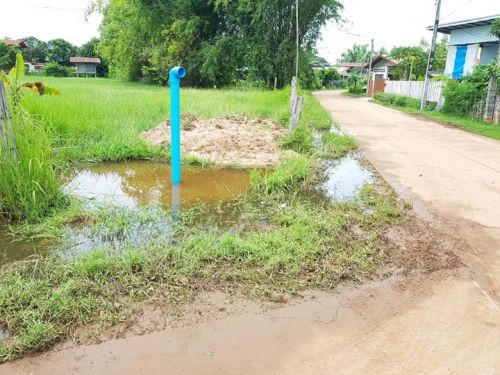Groundwater Bank
An Alternative Water Management for irrigation and household
Introduction
The first successful pioneer project of groundwater bank was innitiated in Nong Kai Province by Abbot Saman Siripanyo, he was sent to Texas USA as Buddhism Ambassador Mission in 1981 during that period Texas was facing serious drought, the local authority has to find mean to alleviate problem by recharging rainfall into the ground to establish subsurface reservoir.
Coming back to Thailand in 1994 Abbot Saman Siripanyo started conduct subsurface reservoir called "groundwater bank" at his temple in Muang District Nong Kai Province. His project created wave of successful that followed by individuals and many local administration organization. Tam Bon Kow Kam, Nam Yeun District of Ubon Rajthani is one of the popular examples that Rotary Club of Sakon Nakhon made a study tour to learn an experience in 2017 and started pioneer project with local administration in Ban Pan District and Muang District in dry season 2018. At the begining it was not easy to convince the benefit of groundwater bank to public but as the time goes by many successful cases of drought alleviation are recognized by seeing as believing, many individuals and public sector like local administration and department of groundwater resources are conducting the same practices.
.jpg)

Definition
An alternative water management technique to recharge rainwater and or used household water to the unsaturated zone below plant roots known as unconfined aquifer, it is technically called man-made underground water reservoir or underground water bank. They are classified into 2 types namely “close system” and “open system” However groundwater bank is shallow well not the deep well
Rainfall is stored in the unconfided aquifer as groundwater bank
Comparision of groundwater bank (shallow well) with the deep well (confined aquifer)
Types of Groundwater Bank
There are 2 types of groundwater bank known as close system and open system
Close System
Minimize water logging caused by rainwater or used household water in the community as well as enhance water harvesting and water saving for small farm activities during dry season. The close system acts like water trap it can be constructed as borehole, long-pit or any characters that can harvest water and recharging into the permeable zone or water bearing rock
How to do
1.Dig a pit diameter 1.5 - 2.00 m and depth of 1.5 - 2.00 m, (or as deep as posible) then fill the bottom section with large size rock or gravel or broken brick and install 1.5 - 2.00 inch PVC pipe as air vent
2.cover the rock filled pit with coarse sand and plastic net
3.topped the plastic net with small size gravel
4.Rainwater is ponding and seeping into the ground through close system groundwater bank

Open System
Recharging run-off to the unconfined aquifer by farm pond (water harvesting pond) equipped with shaft (borehole) to force water into the permeable rock and created underground reservoir. This system is very useful for irrigated agriculture as well as minimizing large scale water logging.
farm pond with borehole down to the water bearing rock (permeable zone)
How to do
1.Construct a farm pond with shaft or borehole down to the permeable rock or unconfined aquifer
Borehole at the bottom of farm pond
2.Rainfall during wet season will fill-up the pond and seeping down to the permeable rock to create underground reservoir
3.More number of the ponds in the neigbouring area are recommended to create large scale underground reservoir
combination of the open system groundwater bank
Objectives
1. 1. Maximum utilization of rainwater for community uses and irrigated agriculture
2. 2.Minimize water logging in the household and community area, thus reduced the risk of mosquito infected diseases such as dengue fever and malaria as well as enhancing environmentally friendly landscape
3. 3.Reducing inflow of contaminated water to the natural lake or reservoir
Solar pump is recommeded for the remoted area
Grow rice with less water is one of the best friend to groundwater bank
Groundwater bank with drip irrigation is recommeded for high value crops
D
Water from groundwater bank fits very well with less water fish farming known as Biofloc System
Case study of groundwater bank and agroforestry
If Groundwater bank of close system and open system were established in 2018 and 2020 to support the "Family Forest" at Dong Rai Farm Waritchapoom District Sakon Nakhon Province
G
Close system groundwater bank
Open system groundwater bank
Installation of observation well to recrd water table
Experiment from 2020 to 2023 shows a satifactory result
The forest trees are growing very fast
Comparision of forest trees of 2020 and 2023
Trees are irrigated during dry season by capillary action of the groundwater bank
Groundwater table is raised from 4.7 m to 2.9 m in 3 years
E
Groundwater Bank enhances fast growing of family forest
Advantages
1. They are appropriated technology with very low construction cost as well as operation and maintenance cost
2. Environmentally and socially friendly project
3. Strengthening local participation and community development
Disadvantage
1.There are some controversial of storing polluted or contaminated water into underground
2.May not be applied to all type of soil structures
Rotary Club of Sakon Nakhon (Rotary International District 3340) and groundwater bank project
Water conservation is one of the objectives of Rotary International, thus groundwater bank was undertaken by Rotary Club of Sakon Nakhon since 2017 many close system and open system of groundwater bank have been conducting in Sakon Nakhon and other provinces in north and northeast regions of Thailand. We have well trained staffs to promote this innovation with on-site demonstration and training course.



